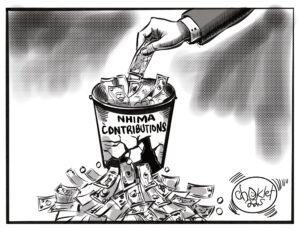The adverse effects that high government debt has on everyday life are widespread; however, much of it goes unnoticed. In the immediate term, the impact of government debt on consumption is not very noticeable, but in the long run, the effects of it can be just as hard hitting as the increased tax burden we discussed last week. In continuing the series on how debt concerns you, this article explains the linkage between high government debt and inflation and what that means for consumers in their everyday lives.
Over the course of a month, you buy lots of different things, the price of which is impacted by a number of different factors, such as the cost of labour, the exchange rate and costs of doing business in the country, such as taxes.
At 7.9%, September overall inflation, the rate at which prices increased in September, was stable — just below the target of 8%. However, this year we have seen food prices rise 8.6% from the year before; and last week Monday we saw fuel prices rise from K13 to K16. The country’s debt levels are not the only cause of price increases, but debt is at the heart of many of the reasons and provides the explanation for why we can expect further inflation. According to the Jesuit Centre for Theological Reflection’s (JCTR) Basic Needs Basket (BNB) for the month of September, an increase in the cost of living is expected from the current K5356 for a family of five. The importation of oil dominates many other expenditures and forms a major part of Zambia’s import bill. Because of this, adjusted fuel rates are expected to negatively impact the prices of essential goods and services such as food, water, sanitation, electricity, health care and housing.
Debt has a strong link to the stability of the Kwacha, which, in turn, impacts the everyday lives of consumers through inflation. Over the past few years, the Zambian government has been issuing bonds. When a government issues a bond, it is accepting a loan to finance certain activities. Foreign investors buy government bonds in order to make money through interest repayments. These investors assess whether to invest in a country by assessing how likely the country is to default, that is, not pay back its debt. This assessment is done by analysing the economy’s immediate and long-term performance. Foreign investors assess the country’s financial position, plans for managing debt and prospects for growth through documents such as the medium-term expenditure framework and budget.
Lately, investors have been becoming concerned about Zambia’s debt levels being unsustainable. We see this in the high interest rates on Zambian debt. We also saw evidence of this in September when investors drastically reduced investment in government bonds. As buying bonds requires converting foreign currency to kwacha, demand for the kwacha fell, contributing to the depreciation of the Kwacha by 20% from K9 to K12 to the dollar that month.
When a currency is weakened, importing goods become more expensive. Zambia being a country that is heavily reliant on imports will be adversely affected by the depreciation of the currency. This means that anything imported becomes much more expensive. The increase in petrol prices, driven by a combination of rising oil prices and Zambia’s weak currency, is the most dramatic example of debt-fuelled inflation. However, food prices are increasing steadily, and as businesses adjust to higher import prices, more prices will increase in the near future, leaving Zambians increasingly squeezed.
The picture does not look very positive for the value of the kwacha. Firstly, the government has not offered investors reassurance that it is managing the debt position, as the kwacha has continued falling in value after the budget announcement on 28 September. Secondly, the country’s foreign exchange reserves, which the Bank of Zambia uses to buy kwacha and stabilise the currency, are under pressure. The Minister of Finance announced that the reserves had fallen from $2.1bn in December to $1.8bn at the time of the budget and are below target. As the reserves are needed to pay increasing debt servicing and petrol costs, the Bank’s scope to manage the value of the currency is limited.
While inflation has been triggered by the depreciation of the kwacha in September, debt has created other long-term and emerging pressure on prices. Businesses pass on borrowing costs caused by high interest rates to consumers, as well as the risk of reduced cashflow due to government arrears. Furthermore, tax increases will also create inflation as businesses pass any additional costs of doing business.
The last few weeks have shown just how the country’s debt position is hitting ordinary Zambians pockets. Not only do citizens have to pay off the debt through increased taxes, incomes are being squeezed by inflation. And the country is in danger of entering a spiral as economic growth slows and investor confidence drops further, driving ever higher inflation. The budget offered an opportunity for the government to provide investors with assurance that the country was stabilising its finances. Instead it borrowed nearly K30 billion. If it is to stop inflation hitting ordinary Zambians, the government needs more transparency in the scale of the problem and more credible plans to address it. Otherwise, we will all pay.
Continue to follow the series for the next coming weeks and follow the conversation on social media #DebtConcernsMe.
Facebook – Consumer Unity Trust Society – CUTS Lusaka
Twitter – @CUTS_Lusaka
























